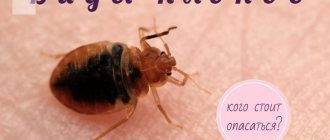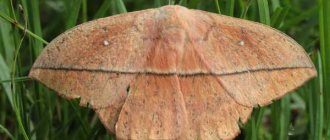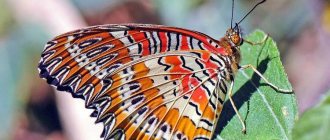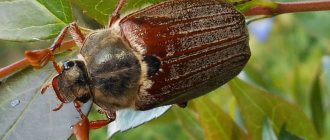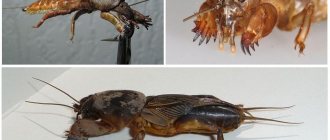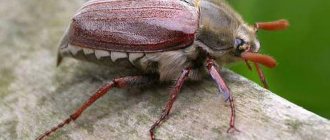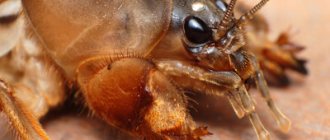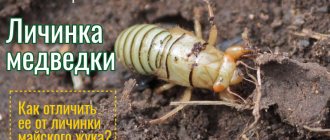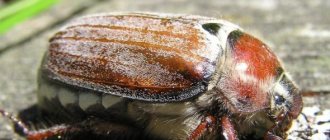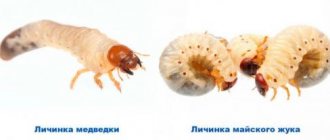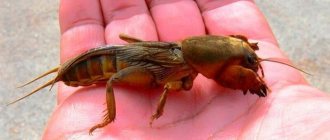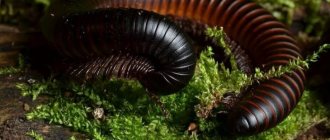Bronze beetle larvae and May beetle larvae, what is the difference? I didn't know. I think that many people do not know, but the cockchafer larva is an enemy, and the bronze beetle larva is a friend.
2012, potatoes were harvested, from 5 sq. m turned out to be 90 kg of potatoes . When harvesting potatoes, I collected a lot of fatty larvae, but examining each tuber, I did not find any damage to the potatoes. I've heard a lot that the larvae of the beetle (Chafer beetle) eat potato tubers. But they didn't touch my potatoes. I don’t use chemistry like “Prestige”, I don’t use any chemistry. Then why weren't they touching my potatoes?
I addressed this question to Alexander Viktorovich Timokhov by e-mail. ( MSU named after M.V. Lomonosov, Faculty of Biology, Department of Entomology, since December 1, 1995. Candidate of Biological Sciences since 1998).
I sent him photos of the larvae
Bronze beetle larvae
.
This is what A.V. Timokhov answered me: “Judging by what I see in the photo, these are larvae of the bronze beetle.
They have never been serious pests. More or less noticeable damage can be expected if only they occur in approximately the same quantities as in the first photo per 1 sq. meter. And even then......"
Taking my word for it, I didn’t think about it anymore. Moreover, you don’t often see the cockchafer here, but bronze beetles fly all summer.
This is a bronze, photo from the Internet.
This is a cockchafer. Photo from the Internet.
All my beds are mulched with fresh grass. Active mulch. Intensive beds.
If there is not enough grass, then I mulch with old leaves. Constantly, especially when harvesting potatoes, I found such larvae in large numbers, but they did not touch the potatoes. The entomologist was right!
I used to give all the larvae that I found to the birds.
Time has passed.
In the fall of 2014, my son and I put compost in boxes. (For what - it is written HERE ). My son noticed the very good quality of the compost. And, surprisingly, the best compost was where the larvae were swarming! It wasn't even compost anymore! Most of all, it looked like granular black soil! We selected the larvae by hand and gave them to the birds.
Another year has passed. In the fall of 2015, my son’s girlfriend helped me move the compost. This time, she noticed that where there are a lot of larvae, the compost is of excellent quality! And I remembered my son’s words last year….
That's it, young people notice everything when they want! And I? Sclerosis, you need to write it down...
We selected the larvae and poured them into a box with fresh compost (the box was filled in 2015). I don't know if they will survive there in the winter or not, but I hope they will. Starting in the spring, I will release bronze larvae there.
Conclusion:
How to deal with larvae
Knowing about all the harm that mole crickets and cockchafers, as well as their larvae, cause to plants, it is necessary to begin control and prevention measures at the first signs of their presence.
The fight needs to be carried out comprehensively, it is better to do this several times a year. Today, many traditional and modern methods of getting rid of pests are known: scaring away, traps, loosening the beds, destroying the nest and destroying with ready-made means. Let's look at a few of the most popular:
Agrotechnical. It consists of carefully digging the soil in spring and autumn to a depth of approximately 15 cm. This helps destroy tunnels and makes it difficult for pests to move. In addition, in this way you can destroy clutches of eggs and larvae.
Dung traps. It is known that these insects love manure and winter in such places. You can make holes about 50 cm in size in the fall and fill them with manure. After the first frost, dig everything out and scatter it on the ground. Thus, the pests will quickly die from the cold.
Oil or soapy water. Oil is dripped into the detected passages or water and soap are poured from a hose. For 10 liters of water, it is enough to take 50 g of soap.
Beer trap. A glass jar is buried in the soil so that the neck is at ground level. Beer is poured into it to fill 1/3 of the container. Place a board on top so that a 15 mm gap remains. This smell is very attractive to insects.
Scaring away. This is done by placing coriander, garlic, chrysanthemums and pine needles on the site. When fish is placed in each hole during planting, it will decompose and begin to emit a specific odor that these insects do not like.
Physical barriers. You can protect plants from pests if you plant them in cut rubber tubes of a certain diameter. They should rise 3 cm above the ground. The rhizomes can be protected with a nylon mesh in several layers, and its edges should be above the soil.
To prevent this, you need to make some efforts, and then the earth will thank you with a good harvest.
Contents of Congolese bronzes
For the comfortable well-being of 4-5 insects, an insectarium measuring 40x30x35 cm is needed. A layer of substrate about 15 cm thick is placed on the bottom.
You can use ready-made soil for bronze insects or prepare it yourself. To do this, mix equal proportions of garden soil, crushed rotten deciduous wood and finely grated last year's leaves.
The insectarium is decorated from the inside with twigs and small driftwood. Adult beetles will be able to climb on them, and the larvae will be able to attach cocoons. The temperature is maintained in the range of 20°C-26°C, and air humidity is not lower than 70%. It is necessary to spray the insectarium walls and soil with warm water daily. Be sure to have a drinking bowl and a separate feeder.
Uneaten food must be removed regularly, otherwise the risk of infectious fungal diseases increases.
Adult beetles are fed with cut pieces of bananas, oranges, pears and apples. It is recommended to give the larvae a little dry cat food as a protein supplement.
As they grow, the substrate should be replaced, leaving about 10 parts of the old one to maintain the microflora.
How to deal with mole crickets and cockchafers?
Since the life activity of the cockchafer and the mole cricket is somewhat similar, and the methods of their sabotage are practically the same, we can identify several general methods of combating them:
Agrotechnical method of pest control
After harvesting in the fall and before planting in the spring, it is necessary to dig the soil deeply and thoroughly. In this way you will destroy the underground passages of the mole cricket, destroy its larvae and egg laying. In order to deal with the Khrushchev, you need to destroy its larvae in the process of digging.
At the end of May - beginning of June, it is necessary to loosen the soil, which will prevent the molting and pupation of the larvae of the cockchafer and will lead to their death. However, this method may not work in dry summers, when the beetle larvae migrate to great depths.
You can repel pests by planting special plants around the perimeter of the garden bed. For example, marigold scares away mole crickets. Lupine is poisonous to the cockchafer.
Pest control using special watering solutions
So a solution of potassium permanganate (1 to 200) will help cope with the voracious larvae of the cockchafer. Plants need to be watered with this solution. You can also use a solution of ammonia and table salt for watering (2 tablespoons of ammonia + 200 grams of salt per bucket of water).
To combat mole crickets in your area, you should use an infusion of chicken droppings (2 kg of droppings per 10 liters of water) or onion peels (1 kg of peelings per 1 liter of water). Before watering, both infusions are diluted with water 1 to 5.
Chemicals against pests
Remember, fruits and vegetables can only be eaten after 30 days from the date of treatment with chemicals.
To combat mole crickets and cockchafers, drugs such as Medvetox-U, Vofatox, Thunderbolt, and Prestige are used (for more details, read the instructions for the drugs or consult with specialists).
Hand catching mole crickets and cockchafers
Of course, you can try to catch harmful insects manually, although this is not too easy. Regular vegetable oil is suitable for baiting mole crickets. It is necessary to pour a few drops of oil into the mole cricket’s hole, and then half a glass of water. The mole cricket that came running in response to the smell will not bother you anymore.
Since chafers fly at night, “light traps” can be prepared for them. To do this, hang light bulbs over containers of water to which a few drops of kerosene have previously been added. The beetles will fly towards the reflection of the light and end up in the water.
Prevention against mole crickets and cockchafers
Take a careful approach to prevention - after all, this is the main way to combat pests. Monitor your garden carefully. Remove and burn old boards and stumps, remove the remains of last year's fruits, and fight excess moisture.
Pest Control
The consequences of the presence of the mole cricket and the cockchafer in your garden are enormous and their principles of sabotage are similar. Therefore, there are some general methods for controlling these pests. Let's look at ways to effectively get rid of these insects.
Agrotechnical method. After harvesting and in early spring, you need to not only loosen the soil, but dig deep in order to disrupt all the underground passages of the mole cricket and destroy its egg clutches and larvae. To get rid of the May beetle, it is necessary to destroy its larvae when digging. And in May and early summer, loosening the soil will disrupt the conditions for molting and pupation of beetleworm larvae, as a result of which they will die. You should know, however, that in a dry summer the larvae of the cockchafer will lie half a meter deep in the ground and this method will not work.
Planting in places where pests of special plants occur. The mole cricket is repelled by the smell of marigold; plant this plant around the perimeter of the garden bed. A field infested with beetle larvae can be planted with perennial lupine, since other weeds will not grow here; the beetle larvae will have to feed only on the roots of lupine, which, in fact, is poisonous to them.
Watering the area with a special solution. An area inhabited by a mole cricket should be watered with an infusion of onion peels or onion waste (900-1000 g of onion peel, pour 10 liters of warm water, leave for 5 days). Before watering, the infusion is diluted with water 1:5 and the plants are watered 2-3 times every 5-7 days, preferably after rain or organized watering. An infusion of chicken manure (2 kg per 10 liters of water) also helps against mole crickets. After diluting with water (1:5), dry soil is watered with it.
A solution of potassium permanganate (5 g per 1 liter of water) will save you from the voracious larvae of the May beetle. Plant bushes should be watered with it. Another effective way to water beds from beetle larvae is to prepare a solution: 200 g of regular salt and 2 tbsp per bucket of water. l. ammonia. During the flowering period it is used for pest prevention.
Capture of adults. One of the most environmentally friendly ways is to lure, catch and neutralize. We lure the mole crickets into vegetable oil. Pour a couple of drops of vegetable oil into the hole left by the mole cricket, then pour in water (no more than a glass). The mole cricket will crawl to the smell and die. The cockchafer flies well, often at night, so you need to make a light trap for it. We hang the light bulbs, and under them containers with water and a few drops of kerosene. The beetles end up in the water when they fly into the light. If you don’t want to rack your brains with traps, then in the morning just brush the beetles off the branches onto the blanket and burn them or pour boiling water over them.
We use helpers in the garden. Some gardeners have noticed that if a couple of cats live on the site, then the plants remain in their places, because cats catch everything that moves, including mole crickets. Starlings will be good helpers in the fight against cockchafers and their larvae. Hang up a birdhouse and you don’t have to worry: it has been proven that one singing family destroys up to 8 thousand cockchafers and larvae. Even ordinary chickens will help you destroy cockchafer larvae.
Chemical attack. If you decide to radically control pests and use chemicals, remember that you can use products from the garden only 30 days after the last treatment. For the mole cricket and its larvae, Vofatox, Medvetox-U, and Thunderbolt are used. The drug “Regent” is mixed with boiled buckwheat and drops of beer (for smell).
Potato plants and tubers are treated with Prestige against mole crickets and May beetles. For soil from cockchafer larvae, use Medvetox U, Gromoboy, Gromoboy2. The garden is treated immediately after flowering with the following preparations: Aktara, Arrivo, Decis, Sherpa, Match, Confidor, Confidor Maxi.
Prevention has always been one of the effective methods of pest control; inspect your garden and vegetable garden. Uproot old stumps, remove rotten and rotten boards and beams from the ground, if any. Mole cricket and cockchafer, their larvae are harmful and dangerous insects. They multiply very quickly, so pest control must be balanced, clear and thoughtful. This way you will save your long-awaited harvest and protect plants and trees from damage.
The best traditional methods
You can also get rid of the cockchafer using traditional methods.
Manual collection
The easiest and safest is to collect the larvae by hand. Experienced gardeners know that in late spring and summer these pests crawl to the surface of the soil. At this time, you should wait until evening and dig up the soil. After tilling the soil, a large number of larvae will appear on the surface, which can be collected manually and immediately destroyed. Of course, it is impossible to remove all pests in this way. But it is quite possible to significantly reduce their population.
Planting
Another popular method of protecting a site from pests is to plant plants that repel them next to trees or a vegetable garden.
White clover is most often used for this purpose. The fact is that May beetle larvae cannot tolerate nitrogen. And soon after planting, bacteria form on the roots of this plant that can absorb it from the air. Over time, it accumulates in the soil, and the habitat becomes unsuitable for cockchafer larvae. This forces them to actively look for a new place of residence.
Attracting insect enemies
Insectivorous birds and other small animals are natural enemies of cockchafers. Therefore, they do an excellent job of reducing their population. In order to enlist their help, you just need to learn how to attract these creatures to your site. The easiest way to do this is to hang a birdhouse on one of the trees.
Poultry can also help control pests. If you release chickens into an area with dug up soil, they will very quickly collect and destroy the larvae. Moles and hedgehogs help fight larvae.
To destroy larvae in the greenhouse and on the street, you can use various folk remedies. They are great against these pests.
- Onion peel. A decoction of dry onion peels is the best way to deal with voracious larvae. To prepare it, the bucket needs to be filled one-third full with husks. Afterwards you need to fill it with warm water. All this should be left for 4-5 days. After the required time has passed, the infusion should be diluted with water in a 1:1 ratio. It should be used for watering plants. This is best done in warm weather.
- Garlic. This is another effective solution. To prepare it, you need to take 100 grams of chopped garlic, pour 5 liters of boiling water over it and leave for 4-5 days. After this, the solution also needs to be diluted with water. The proportions are the same as in the case of onion peel infusion.
- Potassium permanganate. This drug also repels cockchafer larvae well. To prepare the solution, 5 grams of the product must be dissolved in 1 liter of warm water. The resulting product can be used to process various crops. But most often it is used to protect against potato pests.
- Walnut leaves. The collected leaves must be poured with 10 liters of boiling water. The tincture should be left in a dark place for a week. After this, it must be filtered and immediately used for soil treatment.
- Sagebrush. This pungent-smelling plant also repels larvae. To prepare the solution, you need to chop 300 grams of fresh wormwood and mix them with 200 grams of wood ash. All this must be poured into 10 liters of boiling water and left for 3 hours. The finished infusion is also used immediately.
To prevent re-infection of the area with cockchafer larvae, you should adhere to the following rules:
- when digging up a site for the winter, the soil must be sprinkled with bleach or sprayed with “Whiteness”;
- You can also add ground eggshells to the soil in the fall;
- to protect strawberry bushes from pests, it is recommended to treat the beds with a light solution of ammonia;
- In spring, you should not water the beds with a solution of chicken droppings, as it can attract pests;
- the soil must be thoroughly mulched - you can use spruce branches, tree bark or chopped straw for this.
To learn how to get rid of cockchafer larvae, see the following video.
May beetle and mole cricket: comparison of larvae
First of all, we should return to the features of the mole cricket’s metamorphosis. As mentioned above, it is an insect with incomplete transformation, that is, young animals emerge from the egg, which in appearance resemble sexually mature individuals. Therefore, the mole cricket larva cannot look like a caterpillar - it looks like a smaller copy of the imago.
And if we talk about the larva of the cockchafer, then it will already be similar to a caterpillar. A more detailed description of it is as follows:
- the body is painted white, about 2 cm long and no more than 0.8 cm thick;
- on the front of the body there are three pairs of legs;
- there are small hairs on the body and legs;
- dark brown dots are clearly visible on the sides;
- the back of the body is darker.
As you can see, recognizing the pest is quite simple. And knowing who exactly settled on the site, you can quickly get rid of the uninvited guest. But remember that the fight against mole crickets should begin immediately - as soon as eggs or several adult insects are discovered. If you do this, the parasites can cause quite serious harm. They attack any grain and fodder crops, as well as vegetables, young plants and seedlings of fruit, berry and ornamental crops. At the same time, the mole cricket settles both in open ground and in greenhouses. It mainly gnaws out grains and underground parts of plants, but sometimes it can also eat seedlings. As a result of its activity, plants weaken and die over time. But the loss can also be direct; this happens when insects damage potato and sugar beet tubers.
Don’t waste time and start destroying the mole cricket immediately. Have a good harvest!
Signs of plant infection
Adults feed mainly on leaves. They eat or make holes in leaf blades, damage buds, ovaries and flowers. Because of this, the process of photosynthesis in plants is disrupted, they weaken and wither.
The larvae cause more harm; they are voracious and damage plant roots; 3–5 of them can completely destroy the root system of a young tree. Even minor damage makes the plant vulnerable to pathogens. Young plants wither and are easily removed from the ground, and adult specimens, having a reserve of vitality, do not die, but slow down their development. Yields of vegetables and fruits are reduced, side shoots on trees do not ripen well.
Adult insects and larvae are easy to detect on above-ground parts and in the soil and make sure that they are the cause of crop damage.
Mole cricket and its larvae
The terrifying appearance of the burrowing mole cricket beetle is familiar to many gardeners - a large brown, big-eyed insect with claws for digging the ground. And the harm these insidious creatures bring to the site is undeniable - they feed on earthworms and root crops, actively gnawing the roots of cultivated plants during their underground movements, and multiply quickly.
Most often, an inexperienced summer resident can bring a mole cricket to the site along with manure or compost, which these insects also do not disdain as a food product.
But what does a mole cricket larva look like and is it dangerous for the garden? Female mole crickets make nests underground where they lay hundreds of eggs. Hatching larvae have a body shape very similar to an adult insect, only much smaller and lighter, and at first they do not have eyes. They develop over several years, are less mobile than adults, and have weaker jaws, but they eat the same things: small roots, bulbs, worms, plant seeds, and small insect larvae.
Despite the fact that the mole cricket is mainly an underground dweller, it flies and swims beautifully, so it is not easy to catch and destroy it. What to do? Use several methods of pest control at once - both folk and “official”.
Plant marigolds, calendula, chrysanthemums, parsley, onions, and garlic in the garden - their pungent smell is unpleasant to insects. Pour infusion of onion peels or soapy water into the discovered holes made by mole crickets in the ground, or add calcium carbide (after rain it will react chemically with water, releasing acetylene gas, which is poisonous to insects). Use proven chemicals (Medvetox, Antimedvedka, Medvetsid, Rembek, Boverin, Fenaxin Plus, etc.).
How to deal with mole crickets - effective drugs and folk remedies Don’t know how to get rid of mole crickets on your property? Our recipes will help you protect your garden crops from this underground pest.
Preventive actions
You can protect your site from the invasion of voracious creatures in a fairly simple way, by digging deep into the site 2 times a year. Using this method, it is possible to destroy nests, as well as destroy larvae that are in the last stage of development.
Anyone who uses regular manure as fertilizer should know that it is best to apply it in the fall. Once scattered around the garden, in the spring there will be no living mole cricket eggs left, as they will die from frost. When manure is applied in the spring, a person infects his plot with his own hands.
There are other ways to protect your area from these parasites. For example, planting beds with garlic, as well as using garlic cloves when planting garden crops, can significantly reduce the scale of infection of the area. Flower beds with marigolds, chrysanthemums, calendula, etc. have the same effect.
Pest control in the garden plot should be comprehensive.
Here it is very important to combine various methods of control, including the use of chemistry. Traditional recipes often do not help to completely get rid of pests, so you have to use insecticides
Chemicals not only quickly destroy pests, but are also able to protect the area from them for a long time.
Metamorphosis
First, we will look at how mole crickets reproduce. This period falls at the end of spring - beginning of summer, when the air temperature remains quite high at night. However, in greenhouses, clutches can be found much earlier - they are often discovered as early as March. After mating, females go into the soil to a depth of about 10-15 cm, making burrows in it, which are combined into a small nest. Moreover, the vault of such a “room” has a dome-shaped appearance and rises somewhat above the surface of the earth.
In one clutch there are usually several hundred eggs, from which, after some time, larvae appear. Moreover, the latter are very similar in appearance to adult individuals. It should be immediately noted that mole crickets are insects with incomplete metamorphosis, and therefore they do not have a pupal phase.
Some gardeners often mistake a cockchafer larva for a mole cricket larva, and to correct this situation, we suggest you find out what a mole cricket looks like at each stage of its development?
Eggs
They have an oblong shape and are colored light brown. The size of the eggs is small and is no more than 3.5 mm in length. For their normal development, sufficient humidity is required, which is constantly monitored by adult individuals, and depending on weather conditions, they close and open the entrance hole of the burrow from time to time.
The eggs of mole crickets are somewhat reminiscent of ant clutches in appearance, only in the latter they are slightly smaller. At the same time, it is quite difficult to crush a mole cricket egg, since it is covered with a dense film on top. Development in the egg under optimal conditions lasts about two to three weeks.
Larvae
So that you no longer confuse mole cricket larvae with other parasites that live in the soil, we have prepared a detailed description of them. We should start with the fact that the young that emerge from the eggs resemble spiders. This phase is called the first instar larva. The structure of their body, the length of which at the first stage of development is about 15 mm, is in many ways similar to adult individuals, but there are also certain distinctive features:
- they have only 6 legs, not 8, like a mature mole cricket;
- they are blind;
- They eat only the embryonic yolk, which is in their crop;
- First instar cabbage larvae do not have wings.
Before turning into an adult insect, the larva experiences several moults with an interval of 3-4 months. After the first, her diet becomes more varied: the young can already feed on humus, the remains of the shell and the salivary secretion of the female, which remains on the walls of the hole.
A month after hatching from the egg, the larvae become very active and voracious. By autumn, the young reach 3-4 years of age and leave the nest. They move through tunnels that were previously dug by their parents and switch to the usual menu for adult insects: they eat roots, bulbs and lower stems of plants.
Having the opportunity to eat normally and move quickly, the larvae go in search of new habitats. The full cycle of their development takes about 2-2.5 years and after the last molt they turn into adults, fully ready for further reproduction.
Since the metamorphosis of these insects is quite long, in the cold season the larvae have to look for a place to overwinter. This role is usually played by vertical passages in the soil. In spring, the parasites awaken and continue to develop. And at the same time, their survival in harsh conditions and further fertility directly depend on how much nutrients were accumulated by pests before winter.
How is this parasite different?
The first feature that catches your eye is its gluttony. It is believed that its homeland is North America. He remained in the shadows for a long time until he began to rapidly destroy entire potato plantations. The pest is easy to distinguish from other similar parasites, since it grows up to 2 cm in length, and its body is covered with a shell of red or bright orange chitin. Until the 40s of the 20th century, this pest did not yet exist in Europe. He happily eats not only potatoes, but also tomatoes, eggplants, peppers, etc. As a rule, the greatest danger is posed by the larva of the cockchafer, which penetrates into the soil along with humus. After wintering, insects climb out of the ground to the surface in search of food. Insects wait out cold and frost at a depth of about half a meter, so fighting them is not easy.
With the arrival of spring, female cockchafers begin to lay eggs, after which larvae emerge from them, and they are quite voracious and eat everything that comes in their way. Externally, the larvae look like white caterpillars with many small legs. They live for about 4 years. The larvae are armed with quite powerful jaws, as a result of which they can destroy the root system of any tree, not to mention garden crops.
Somewhere in the height of summer, the larva begins to develop into a pupa, which resembles a real adult cockchafer. By autumn, the pupa turns into an adult, which overwinters in the ground at great depths. This allows the cockchafer to survive the harshest winters.
The survivability of this parasite is associated with many factors. For example:
- In Europe, the cockchafer has practically no natural enemies, compared to its homeland.
- If there are no favorable conditions and there is not enough food, then the cockchafer can be in a state of suspended animation for 3 years. After this period, the parasite is able to come to life and begin its “violent” activity.
- Female insects lay eggs at great depths, so no agricultural measures can affect this process. Therefore, the destruction of such pests must be carried out during the period of their active life.
- The cockchafer has strong wings, so it can easily fly a distance of 10 km. As a rule, they migrate in entire colonies in search of food. At the same time, they capture significant territories.
- To destroy this parasite in a vegetable garden or garden plot, you need to put in a lot of effort and money.
Despite this, many effective means have been developed that can cope with the invasion of the cockchafer. At the same time, it must be remembered that chemical control agents require special protective equipment, otherwise they can harm humans, although in our time drugs with minimal toxicity are produced.
Interesting! The favorite delicacy of cockchafer larvae is the root system of garden strawberries or wild strawberries. If you notice that strawberry bushes have begun to fade just like that, without obvious reasons, then you need to dig them up immediately. As a rule, the larva of the cockchafer is also located here. If you don’t do this, the larvae will simply mow down every single bush, not a large plantation of this delicious and healthy berry.
https://youtube.com/watch?v=YKkL6pT7pzk%3Frel%3D0
What does a mole cricket and its larvae look like?
The mole cricket is a species of Orthoptera, does not have clear geographical boundaries of habitat, and is found wherever conditions allow. The peak of active life for mole crickets occurs when night has fallen, and during the day they sleep in their earthly houses. If the pest eats well, the mole cricket can reach up to eight centimeters in length.
If you see a parasite in your area that looks like a shrimp or locust with tentacles, then it is a mole cricket. In addition to her interesting appearance, she has the ability to quickly run, fly, and swim. He uses these qualities when he really needs them, but mostly likes to dig deeper into the ground. And in order to leave her offspring, the female makes depressions in the ground so that the sun warms the clutch well, and so that the rays successfully fall on the clutch, the beetle clears the ground of plants, eliminating obstacles to the rays.
A clutch can contain up to a hundred eggs. They are shaped like oblong grains and the color varies from beige to light brown. When the larvae emerge from the eggs, their body is very similar to the adult, but much lighter. Many people imagine it as a white worm, but it is not so! Juveniles are full of energy and very voracious. They develop for about 2-2.5 years, and when the last molt has passed, they are ready to reproduce. They wait out the winter in the ground.
Types of May beetles, photos and names
To date, zoologists know 63 species of cockchafers; below we will describe the most interesting of them.
Eastern May Khrushchev
He is also the eastern May beetle, he is also the wild chestnut beetle. This species is characterized by pronounced sexual dimorphism; females are significantly smaller than males: 20-29 mm long in males versus 10-15 mm in females. It has a variable color, although in general brownish and red colors predominate. Also distinguished by its black antennae. The Oriental cockchafer is very numerous in Europe and Asia.
Western May Khrushchev
Also known as the Western cockchafer. It is longer in size than its eastern relative, with a strongly convex body. They are almost the same in size, but differ in some habits and details of appearance, for example, the Western Khrushchev in the spring appears 10 days later than the Eastern one, it is more thermophilic and likes to settle in fields. His antennae are not black, but light brown or reddish-brown. Lives in many European countries. In Ukraine, many beetles of this species live in the Odessa and Kherson regions, in the lower reaches of the Dniester.
Caucasian May Khrushchev
It is a representative of a rare species of May beetles. Currently it lives exclusively in the southwestern part of Germany and Austria. It differs from other species in having a short, more rounded pygidium. They also have whitish scales on the elytra, which sometimes almost completely hide their main color.
Dream Interpretation - Linen
Underwear seen in a dream means winning or receiving an inheritance. If the linen is torn, a disruption may occur in your career. Rust stains on linen - expect guests. Linen hung to dry portends quarrels and discord with friends and loved ones, loneliness. Twisting wet underwear is unseemly deeds. Hanging it on a rope yourself is a disease for a close relative. Removing dry things from the rope is a disaster in the house. Ironing clothes with an iron is a noisy visit from a cheerful company. Wash clothes - start a general cleaning in the house or workplace. Seeing dirty laundry means family squabbles and troubles. Seeing clean, fresh-smelling linen on the shelves of a closet is a sign of material well-being. Putting on underwear means learning interesting news. Walking around with a headset means you will be overcome by restless thoughts. Buying linen means arranging family matters.
Lifestyle
Mole crickets are the oldest inhabitants of the planet; the fossil remains of some species that lived on the territory of modern Europe are about 30 million years old. These insects are extremely tenacious and easily adapt to any living conditions, so they are found everywhere.
Medvedka.
Today, the mole cricket family includes about 110 species, among which the most widespread is the common mole cricket, which is found in Eurasia and North Africa. The favorite habitats of mole crickets are fertile plains warmed by the sun, sandy soils and garden plots well fertilized with manure. These insects avoid deserted, dry places and try to stay in coastal areas in dry years.
Medvedka.
May beetle (Khrushchev): description, structure, characteristics. What does a cockchafer look like?
The May beetle is an arthropod insect and belongs to the order Coleoptera, the family Platinaceae, and the genus of May beetles.
As for insects, the cockchafer is quite large, some individuals reach 17.5-31.5 mm in length. The body of the Khrushchev is wide and convex, elongated oval in shape, with a black or red-brown color. Also, the body of the cockchafer is protected by a chitinous shell; it itself consists of a head, chest and abdomen. In turn, the insect’s thorax consists of three segments, and the abdomen of eight.
The wings of the cockchafer are protected by rear elytra of a reddish-brown or yellow-brown color. The beetle's head is small and retracted into the elytra; it is dark in color, although there are beetles with a greenish tint on the head.
The cockchafer is also a very hairy creature; it is almost completely covered with hairs of different lengths, thicknesses and colors. Typically, the colors of the cockchafer's hair are white, yellow or gray, and, interestingly, in some beetles the vegetation can be so dense that it even hides the main color.
The longest hairs, collected in longitudinal stripes, adorn the head of the cockchafer. The elytra have long, single protruding hairs, while the chest is strewn with yellow hairs.
The beetle's abdomen, consisting of eight segments, also has small openings - spiracles, which play an important role in the life of the insect; it is through them that air enters the respiratory tubes, trachea and is distributed throughout the beetle's body.
The cockchafer has three pairs of jointed limbs, which also have hairs, especially long on the thighs. The first pair of beetle legs comes from the anterior thorax, the second pair from the mesothorax, and the third from the metathorax. The tibiae of the front legs have 2-3 teeth.
The eyes of the cockchafer are convex, they have a complex structure (each complex eye consists of several thousand simple ocelli), and allows them to see at a wide viewing angle.
The antennae of the cockchafer perform an important olfactory function for the insect; they consist of ten segments, with the third segment being the longest. The flagella of the antennae are strongly curved; in general, they somewhat resemble a club or a fan. In males, such a “mace” is more curved and larger in size than in females.
As for the oral apparatus, cockchafers have a gnawing type, thanks to which they easily eat plant shoots. Along the edges of the mouth there are three pairs of oral appendages: the first of them is the stingers, the second is the lower jaw, and the third forms the lower lip. The upper lip, which is a small plate, covers the movable oral appendages from above. When eating, the beetle uses both the lower and upper jaws, and uses the palps to move food closer to the mouth.
The chitinous shield of the cockchafer has a semi-oval shape, it is large, smooth and glossy.
Nest Features
Mole cricket burrows in the garden are a unique structure with numerous passages and exits. The main part looks like a rectangle. There the insect rests, hides from enemies, and breeds offspring. On the surface, the exit or entrance looks like a large or small hole. You can catch a mole cricket in various ways.
The mole cricket's passages on the ground extend from the nest in different directions. They have a spiral shape, the hole goes to the surface. In this way, the female ensures free air circulation and heat supply. To prevent the area from being shaded by plants, the female gnaws the stems, after which the crops dry out. Eggs are laid at the time when seedlings are planted in the beds, which is why many gardeners have to save them.
Mole cricket habitat
Circulatory system
Like other arthropods, this insect has an open circulatory system. With the flow of blood in the body cavity, internal organs and tissues receive nutrients. The movement of blood is provided by the heart, which pulsates and drives it to the head end of the body. Its reverse flow is impossible due to the heart valves. When the heart expands, blood enters it from the back of the body. The side openings of the central organ of the circulatory system have valves that prevent the reverse flow of blood. This biological fluid does not participate in the respiratory process.
Ways to deal with mole crickets
Plant protection specialists believe that the fight against mole crickets in the garden should begin not with insecticides, but with agronomic measures, which include:
- spring and autumn deep plowing;
- regular loosening of the soil throughout the season to a depth of 15 cm.
This destroys the passages and nests of insects, interferes with obtaining food and destroys the pest mechanically.
For those who, adhering to the principles of ecological farming, do not dig up the soil, the relevant question will be how to get rid of mole crickets without destroying the soil. You can do this:
- Instead of mullein, use bird droppings for fertilizer, which scares the mole cricket away from the beds with its smell.
- Marigolds and small-flowered chrysanthemums repel mole crickets. Plants are planted around the perimeter of the area and a little chopped greenery is placed in the holes when planting seedlings.
When to use chemicals
In agriculture, it is believed that the threshold of harmfulness, after which there is economic sense in insecticides, begins with the figure of 1 individual per 1 square meter. Land owners who have seen how much harm the mole cricket can cause do not wait for the pest to spread much and begin treatment earlier.
To combat the mole cricket, soil granules and treatment of the roots with substances toxic to the insect are used. You must use the medications according to the instructions.
- Poisoned baits - Medvetox. They are embedded in the ground to a depth of 4 cm when digging the beds, in planting furrows or dug trenches and spilled with water. The insect dies after eating the bait.
- Poison granules - Bazudin and Thunder. Embed into the soil, mixed with sand. The mole cricket dies when it touches the pellet.
- Prestige - the roots of the seedlings are dipped into the drug solution for 6-8 hours before planting.
- Aktar - the roots of plants are dipped into a solution of the drug for 2 hours before planting. 1.5 gr. The product is enough for 250 plants.
Folk remedies for mole crickets
Unlike the Colorado potato beetle, which was recently introduced, the ground cricket has been damaging crops for as long as agriculture has existed in the European and southern parts of the country. Gardeners have accumulated a fair amount of experience in dealing with this pest, which will tell you how to get rid of mole crickets in the garden forever.
The fight against mole crickets is effective by catching and destroying adult insects and larvae. In autumn, after the start of frost, the right time comes.
- Dig several holes 2 shovels deep, cover the bottom with film and place fresh manure. Mole crickets, slow at this time of year, crawl into traps for the winter. From there they are selected every morning.
- The trap can be an ordinary jar with water at the bottom, buried at soil level. The mole cricket crawls towards the smell of dampness and falls into a jar.
- Many have learned to destroy mole crickets with soapy water. Dissolve half a piece of laundry soap and a tablespoon of washing powder in a large bucket. Half a liter of this solution is poured into the hole. The mole cricket will die underground or crawl out where it can be destroyed.
- In the literature you can find advice to protect the roots of seedlings from mole crickets by planting plants in the plastic cups in which they were grown, cutting off the bottom. There are many reviews that cabbage and tomatoes grow poorly with this planting method and it is not possible to get a good harvest.
The famous popularizer of natural farming, Nikolai Kurdyumov, describes in his book how his cat eats mole crickets, “crunching them like chips.” Many gardeners have noted that their four-legged friends happily eat insects, hunting for them. In addition to cats, the mole cricket has natural pests: birds, shrews and moles.
Folk remedies for mole crickets can be a sufficient measure to protect small areas from this pest.
Means of struggle
Chemical and biological drugs
Antikhrushch
The insectoacaricide affects the nervous system of the pest, paralyzes it and the larvae quickly die. Indirectly, the drug reduces the risk of viral and fungal diseases.
Before planting potatoes, the soil is sprayed with a working solution at the rate of 10 ml of product per 5–10 liters of water. This volume is designed to process 1 hundred square meters.
To soak the roots of vegetable seedlings and fruit tree seedlings, dilute 10 ml in 3 liters of water.
The soil around strawberries, berry bushes and fruit trees is watered with a solution of 10 ml of the drug and 5 liters of water.
Vallar
According to reviews from summer residents, this new drug is one of the most reliable in the fight against May beetle larvae. 5–6 granules are scattered around the plants in the root zone and embedded in the soil to a depth of 5–10 cm.
Before planting, a mixture of an insecticide solution with soil is prepared to treat the roots of seedlings of fruit and ornamental plants. 3 tsp of the product is added to 200 ml of water and stirred. Pour soil into the container, add the solution and pour in more water, bringing the volume of the “chatterbox” to 1 liter. The roots are dipped into this mass before planting.
Zemlin
Once in the pest's body, the insecticide blocks basic life functions. The larvae cannot move, absorb food and soon die. Granules of the drug are applied to the ground when planting plants in holes or during the growing season at the rate of 30 g per 20 square meters. m.
Bazudin
Contact insecticide with intestinal action based on diazinon. The consumption rate of the drug is 30 g of granules per 20 square meters. m. landing. They are first mixed with dry sand or sawdust, the soil is loosened and the mixture is scattered evenly.
Initiative
An effective contact action drug. Shows protective properties during the first day after use. 30 g of microgranules are poured into a 1 liter container of dry sand, mixed and evenly scattered around the root zone.
Nemabact
A unique biological product for pest larvae based on beneficial nematodes. The contents of the package (foam rubber crumbs) are poured into a colander, which is placed on a bucket and washed with water (10 l), periodically squeezing out the crumbs. The resulting solution is stirred and used to water the soil.
Plants are watered at the root with a strong infusion of onion peels. Half the bucket is filled with onion peels, hot water is added to the brim and left for a day. The infusion is filtered, but not diluted before use. Ammonia will repel larvae from the area. Dissolve 20–30 ml in 10 liters of water and water the soil. This treatment is also good as a preventive measure for strawberry bushes. To prevent the pest, potato seedlings and vegetable seedlings are watered with a solution of potassium permanganate (3–5 g per 10 liters of water). The soil has been watered with the indicated solutions since May, when the pest has already risen to the root layer. Mustard clears the area of larvae; they do not like the smell of this plant. Starting in spring, the row spacing and soil around the trees are sown with mustard or other cruciferous crops. When the green mass grows, it is embedded in the soil. Planting leguminous plants has a similar effect on the pest: lupine, beans, peas, beans. The soil under trees and shrubs can be covered with white clover. On the roots of this plant, as well as on legumes, bacteria are formed that participate in the accumulation of nitrogen in the soil. The cockchafer larvae cannot tolerate this. In May, adults are collected by hand
In the morning, insects are inactive, so when they are spotted, the branches of trees and shrubs are carefully shaken off, the beetles are collected and destroyed. Traps are built to catch insects. Plastic bottles with cut off necks hang on trees
Sweet fermented liquid (compote, diluted jam, kvass, beer) is poured into containers. The cockchafer is attracted to any light source at night. Therefore, the trap is installed next to a switched-on flashlight or light bulb. The bait can be a wide container of water: a basin, a bucket, a bowl. For another option, the inner walls of an empty container are coated with any viscous and sticky substance. The insects that fly to the light will fall into a trap; in the morning all that remains is to collect and destroy them.
Insecticides
As with all cases of insecticide use, it is recommended to resort to them in cases of extreme necessity, when a chemical attack remains the only way to sterilize the area from pests. There are specially developed compositions for the destruction of beetle larvae, but in many cases universal preparations are also effective. In particular, the following remedies can be recommended.
"Bazudin"
Made in Switzerland
The active ingredient is diazinon, which requires careful use and compliance with safety measures.
In addition to beetle larvae, Bazudin is also effective against wireworms and some other harmful insects. It has Russian analogues, these are “Grom”, “Kapkan” and “Dohloks”.
Carefully! “Bazudin” is a dangerous substance for fish and other inhabitants of water bodies, so it should not be allowed to get into ponds and rivers!
"Zemlin" and "Pochin"
They also work against several groups of insects that cause damage to crops. To get rid of the “May” offspring, sawdust or dry sand is poured into a 0.5 liter jar, after which you need to add one package of the product and mix the contents well.
Used when transplanting seedlings to protect them. Add 1 tsp to each planting hole. the resulting composition.
"Aktofit"
It is an insectoacaricide with contact effects on the digestive system. It works due to natural inhibitory toxins with a specific focus. Once in the insect’s body, it affects its nervous system and causes death.
"Antikhrushch"
Made in Ukraine. Insectoacaricide, which is a systemic 2-component contact disinfectant. Effective against several types of insects that damage crops. Like Actofit, it blocks the functioning of the nervous system, causing the death of individuals at all stages of formation.
